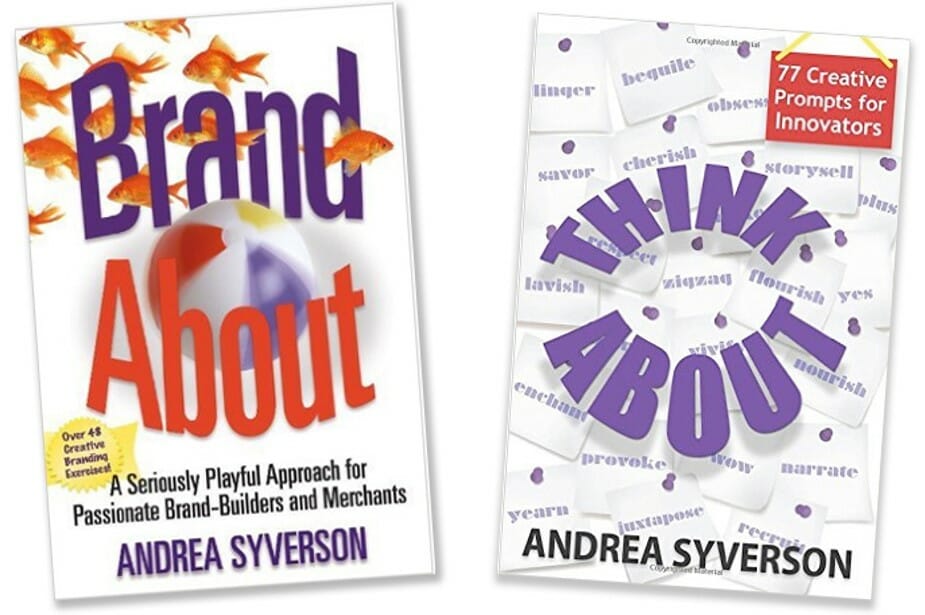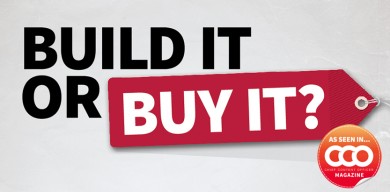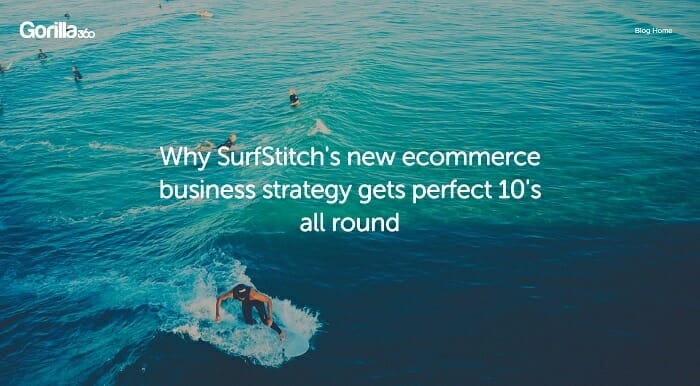Andrea Syverson is a retail strategist on a mission.
With decades of success stories smushed into her enviable track record, you’d think Andrea would be content to cruise along to the finish line.
Not Andrea. Her laurels aren’t a place for resting any time soon.
Andrea has successfully improved the customer experiences of brands like Hallmark, Ben & Jerry’s, World Vision and SPANX – and I want give you an insight into how she does it…
Apart from managing her own creative consultancy, IER (which stands for Ideas, Execution, Results), Andrea has also authored and published two books focused on retail brand strategy and innovation for budding entrepreneurs.

BrandAbout contains dozens of creative branding exercises retailers can use to find the meaning behind their business. Andrea knows exactly how to draw a clear story out of a brand and communicate this with a target audience, and BrandAbout condenses her years of consulting experiences into one practical handbook.
ThinkAbout is an innovation compendium, showing business owners how to connect to their customers. Using a roster of diverse and successful companies to illustrate each idea, ThinkAbout gives readers actionable prompts to refine and direct creative thinking.
But there’s one critical issue plaguing retail brands that Andrea is determined to banish for good.
Solving this problem has become Andrea’s career quest, and it’s a motivation shared by our tribe at the Ecommerce Jungle Gym – so we want to share with you the framework Andrea uses to turn your customer’s pain into your brand’s gain.
The retail marketing problem your brand can’t afford to avoid
The marketing gospel Andrea is spreading is forehead-slappingly simple, and we Gorillas are singing from the exact same hymn sheet.
Here’s the problem Andrea is out to change:
Ecommerce needs to be more human.

Can I get an Amen!
There’s a hand on that mouse when it makes an add-to-cart click. But in the relentless pursuit of key metrics, we tend to lose sight of the person behind the PayPal account.
The most successful, enduring brands have the strongest relationships with their customers.
They develop these relationships by treating their shoppers as real people – by creating truly helpful experiences designed based on the thoughts, feelings and emotions of their audience.
We Gorillas see a majority of ecommerce brands focusing on their products, their profits and their problems. While bricks and mortar retailers spend huge chunks of their budgets on optimising the shopping experience for the customer, most online stores are still a glorified online catalogue.
Ecommerce marketing professionals are focused on generating sales, paying for clicks and increasing conversions. You tell ’em, Andrea:
“How much human touch – real live human touch – is part of your current brand experience? I believe this is one of the most overlooked aspects of branding and yet one of the best ways to set your brand apart from your competitors.”
We Gorillas agree with Andrea. It’s time you changed your mindset to concentrate on the process, not the outcome.
Delighting your customers is the process.
Repeat sales are the outcome.
Those brands who develop the best customer-delighting experiences will reap the most repeat sales.
And this isn’t just dreamland professor-speak. Andrea is the change agent who makes these seemingly mythical ‘profitable customer experiences’ happen:
“My role is one of customer-centric listener, connector and creator. Being the provocateur is how I’m able to help retailers ignite their brand, and there’s a real joy in helping companies connect more deeply and truly with their customers.”
Over 20 years of working with brands to find their purpose – Andrea has developed and refined a framework retailers can use to create the kind of customer experiences that foster genuine long-term loyalty.
Lucky for us – Andrea has been generous enough to share this framework with The Ecommerce Jungle Gym.
You have the chance to take the outline of Andrea’s framework and turn it into more customer-friendly ecommerce marketing. It’s time you turned your BrandAbout.
You’re just 10 steps away from turning your customer’s pain into your brand’s gain.
Just don’t expect any shortcuts, silver bullets, or magical secrets.
Organised common sense and marketing empathy are Andrea’s tricks of the trade.
10 steps to turn your customer pain points into helpful customer experiences
Andrea always challenges retail brands to honestly answer these two simple questions:
- How does your brand show respect for all the human beings inside (employees) and outside your company (customers)?
- Just how human is your brand?
Andrea’s ten step BrandAbout framework is designed to help brands develop repeatable processes that allow you to create best-in-class customer experiences.
Ecommerce entrepreneurs ought to focus in. Customer experiences are what separates the sustainable loyal-customer-generators from the also-rans who are destined to lose a discounting battle to the death with the Amazons of their industry.
Stage #1. Prepare For Deep Strategic Work
We’re trying to pull off a big strategic play here.
This is not going to be easy.
Turning your customer’s pain points into a problem-solving customer experience is just as complicated as it sounds.
So you need to dedicate some serious think-time to your quest.
Andrea always subscribers her branding clients to Cal Newport’s ‘Deep Work Hypothesis’ before she embarks on a BrandAbout:
“The ability to perform deep work is becoming increasingly rare at exactly the same time it is becoming increasingly valuable in our economy. As a consequence, the few who cultivate this skill, and then make it to the core of their working life, will thrive.”
Deep work requires undivided focus.
You need to set aside the frantic day-to-day churn of your normal work day when attacking a complex concept. If you want to find and solidify the true meaning of your brand, you’ll need to be in ‘deep work’ mode.
Without distraction, you can truly engage in a cognitively demanding task. Place a block in your calendar – a whole day if possible. Set up at a unique location to give you and your team a fresh environment, free of normal office disruptions.
Working on something while in “deep work” mode will produce the best results. This is particularly true for marketing problems. If we want to create genuinely helpful online customer experiences, we need to understand their needs better than anyone else.
Gorilla’s content marketing spirit animal, Ann Handley, is a passionate advocate of the virtues of slow work. You need to heed her blunt advice:
“Wait, what? is an important strategic question. “Slow the *&%^$ down and do your content marketing right — or don’t do it at all.”
George Stenitzer of Crystal Clear Communications is right there with Ann on this one.
He explains why slow work is essential for creating customer-friendly marketing:
“The real question is, does faster and faster address the problem marketers face today? No. Because it doesn’t address buyers’ problems.
What buyers need is not content that’s fast but content that really addresses their needs and solve their problems. It’s so easy to get sucked into the mile-a-minute daily marketing production line. Instead, I’m committed to building time into our schedule for ‘slow work’.
We can make room for this deep work by cutting the fat of the content we produce that our audience just wouldn’t miss were it banished.”
Stage #2. Know Your Customer’s Pain
We have to intimately understand our target audience’s challenges, fears and problems if we want to develop the most helpful online experience in our niche.
We need to develop the systems, processes and structures required to generate rich customer insights. Here are just a few ideas to generate a better understanding of how you can solve your customers’ pain points:
- You need to establish regular meetings with sales and customer service representatives
- You need to conduct regular customer surveys to generate first-hand feedback
- You need to call or email your best customers directly to find out what you’re doing well and how you can improve
We have to become the doctor – know your customer’s pain and help them solve their problems with helpful, valuable and entertaining content.

Ecommerce brands that can make the shift to an audience-building mentality are already starting to dominate those focused on their own products and services. We need to create the type of content experiences our customers genuinely want to read, watch and listen to.
If we can create the best publication in our niche, we can develop lasting relationships with our audience, and convert their trust into repeat sales.
Gather this info and stew on it. Use your slow work calendar block and really think about how your brand can create content that turns these pains into gains. Take the time to move past the generic thoughts and search for the genuine insights.
Stage #3. Listen And Learn From Your Customers
Andrea explains that before you start to create helpful customer experiences, you need to take the time to learn adventurously and listen empathetically. She cites a quote from Nike’s CEO Mark Parker as her inspiration:
“Be a sponge. Curiosity is life. Assumption is death.”
This is the turning point for your company’s mindset.
Shelve any product-first discussion.
Andrea understands the ecommerce reflex to obsess over sales, profits and margins. Those things are your lifeblood.
But, brave and creative marketing professionals know you’ll increase all three if you approach your problems thinking about customer first.
If you’re sceptical – don’t be. The king of the ecommerce jungle, Jeff Bezos built his Amazon empire on this same customer focused foundation, which he explained to IBM’s Think Marketing:
“Always wake up wondering ‘how can we make our customers say, wow?’. We want to impress our customers. That kind of discontent comes from observing customers and noticing that things can always be better.”
You need to put your freshly developed communication processes into action.
Compile the info and feedback you have gathered from regular meetings with sales and customer service representatives.
Collate the results of your customer surveys.
Draw out the insights you snared in phone hook-ups or discussions with your past or present subscribers and members.
This rich, priceless data is worthless without analysis.
Now’s the time to prepare your info for your team discussion.
Stage #4. Conduct A TalkAbout
The TalkAbout concept is inspired by one of Andrea’s trips down under, where she was fascinated to learn about the indigenous Australian aboriginal tradition of the ‘walkabout’. Aboriginal people use the walkabout as a sort of rites of passage.
Young people are encouraged to take an extended break from their normal life to retreat into the wilderness, in order to concentrate on their spirituality. The process helps the individual to develop their identity and understand their purpose in life.
It makes sense for young, aspiring ecommerce brands to do the same.
For a detailed understanding of the TalkAbout process, you’ll need to get your hands on Andrea’s book.
I’ll provide an abridged version of this discovery framework to help you conduct your own version.
Andrea’s TalkAbout helps you turn the data of your regular research process into genuine, valuable insight that you can use to inform your marketing strategy.
Andrea’s TalkAbout involves the following:
- Team Beachball: Discuss the results and insights you generated from your customer research by passing the beachball to each team member for their thoughts.
- Fierce Conversation: Don’t hold back. Provide brutal, honest analysis.
- Pain Assessment: Pinpoint the places your customer hurts. Rank the problems your customers experience that are relevant to your brand in order of severity.
- Pain Solutions: Find the ways in which your brand, your content, and your online shopping experiences can solve your customer’s problems.
- The Strategic Gap: Summarise the purpose of your brand. Write down how you need to change your customer’s life for the better.
- Your Strategic Differentiation: Turn your brand’s purpose into a narrative. What is your brand’s hero journey? How do you intend to communicate your brand’s purpose to your audience in a way that resonates with their emotions?
At this point, you’re starting to progress.
You know your audience’s problems.
And you know how your brand can help solve those problems better than anyone else.
Now you need to work out the best way to communicate this with your customers.
Stage #5. Verbify Your Best Brand Story
Now’s the time to work out your brand’s ‘Pain Youtility’.
This probably sounds like a foreign language to you, but it’s a really important term to understand.
Andrea cites Jay Baer’s portmanteau word merge of ‘you’ and ‘utility’ as a way to describe the value you are providing to your customer. Your brand’s ‘Pain Youtility’ is the problem-solving value you offer to your target audience.
Let’s run through a couple of examples to illustrate Andrea’s point:
- Warby Parker’s PY – bringing designer style and quality to customers at an affordable price
- Lush Cosmetic’s PY – allowing environmentally conscious people to improve their wellbeing sustainably
- Casper’s PY – take the stress and anxiety out of choosing the right mattress to ensure a good night’s sleep
- Huckberry’s PY – help urban outdoorsmen save time in their busy schedules to live their passion
Your PY hones in on the most important way your brand can help your customer.
Once you can isolate your Pain Youtility, you can focus your marketing efforts on providing content experiences specifically designed to cure your customer’s pain.
A focus on your PY ensures your content is valuable, helpful and customer-centric. Without a clear PY, you and your team can lapse back into the old marketing habit of describing the value of your products and services – which loses the interest of your customers.
Andrea uses a beautiful marketing analogy that we Gorillas absolutely adore:
Helpful content should be your replacement for a 20% off discount.
You don’t need to slash prices if you can prove the value of your brand and products.
Instead, use your helpful content as a substitute. It’s a free, valuable product in itself. You can offer this free content product to your potential customers in exchange for trust and loyalty.
At this point, settle on a verb that summarises your brand’s story.
How do you intend to build an audience with your content?
Will you:
- Help?
- Entertain?
- Intrigue?
- Educate?
- Support?
- Organise?
- Evaluate?
- Decode?
- Explain?
- Reassure?
- Expose?
- Surprise?
Settling on your brand’s verb gives you the clarity you need to ensure all of your content is working toward the same strategic goal.
Any piece of content you create must act on this verb.
Better yet, your chosen verb allows you to create a ‘don’t do’ list.
If you know your brand’s purpose is to educate, you don’t need to focus on entertaining, or comparing, or surprising.
Stage #6. Think Like A Publisher
A brand verb isn’t enough.
‘Help’ or ‘Educate’ or ‘Persuade’ is not strong or expressive enough to explain to your team how to execute on your marketing strategy.
Unfortunately we marketing professionals need editorial processes to keep us focused on building an audience and helping our subscribers. Otherwise, our natural instinct to sell is an urge too ingrained to resist. You can’t afford to go all Lyle Lanley on your newfound subscribers…

Give a marketer a bunch of potential customers and watch them turn straight to default advertising mode.
You need to develop the processes and guidelines used by successful publishers to show your team members how to help, educate, inform and entertain with your content until the time is right to sell.
The internet has given you the chance to talk directly with your customers. You can’t just write about your products and services.
Otherwise, your blog becomes a never-ending online steam mop infomercial, save for the irrepressible botoxed smile and unnaturally white teeth.
Your product, category and checkout pages are where you can persuade, convert and sell.
Almost all of the other content you create should be designed to help your audience.
The 6 content marketing fundamentals Andrea urges every brand marketer to remember
#1. Create demand with your content
#2. Differentiate your story
#3. Develop a tribe of evangelists
#4. Aim to become a beloved brand, not just a profit-generating-machine
#5. Make a ‘To-Don’t List’
#6. Banish overused words, phrases and misconceptions from your communications
We could write a whole book on the importance of content marketing for your ecommerce brand.
In fact, we did.
There’s over 34 pages of ecommerce content marketing helpfulness in this e-book guide to Building An Ecommerce Audience You Can Bank On. Grab yourself a copy now to find out the strategy and processes you need to think like a publisher and build your own profitable audience of loyal customers.
Don’t forget you can buy an existing publication for the audience-building shortcut
Instead of creating your own media from scratch – your brand can just purchase a publisher in your niche and acquire their audience.
You get the storytelling capacity that comes along with the business. You don’t waste the opportunity costs involved in building an audience. And you get the consumer behaviour insights that come along with the publisher’s data.
All of this adds up to a tantalising proposition:
When you take into account the costs associated with building an audience of the same size, the buy might end up cheaper
I recently penned a piece for the Content Marketing Institute exploring this very issue, so I am perhaps, a smidgen biased. If you want a detailed analysis of the build or buy decision, it’s well worth a read.
If you want a quality case study from an ecommerce brand making this content marketing strategy work in practice – Aussie surfwear retailers, SurfStitch had blazed the trail for those thinking about buying an audience.
In the meantime, put this concept out on the table. Kick it around. Run the numbers. It could be a cheaper, faster way to success.
Firstly, make sure subscriber acquisition and retention figures are central to your marketing ROI measurements.
Secondly, consider purchasing a publisher’s established audience, and all of the business assets that come along with the package deal.
Stage #7. Think Like A Customer
Create a visual customer journey map.
Place real events and research triggers on the map.
Then create content experiences to solve the common pain points at different stages across the customer’s journey. Work out how to help your customer one step closer to purchase.
Your content must simplify the progression of the customer through the following critical phases:
- Awareness
- Research
- Consideration
- Comparison
- Purchase
- Evaluation
- Repeat Purchase
- Referring Others
Customers make purchase decisions to resolve a frustration they’re feeling or improve their lifestyle. Your brand can use content experiences to convert customers from knowing nothing about your online store – to becoming a loyal repeat customer.
Andrea pinpoints the importance of a shift in mindset. The culture within your ecommerce business must be customer-first, not profit-first:
“The way to master this art of solution-based pain point storytelling is simple: Think like a customer. You’ve heard it before, but how many brand leaders still lead from the company’s vantage point first with thought processes like these: What’s easiest for operations? What’s best for our bottom line? What are our new product features?
This type of company-centric storytelling turns customers away.
Stop.
Re-evaluate all your brand touchpoints through the lens of your customers. If you’ve walked a mile in their wellies, you’ve no doubt heard lots of ways to improve the user experience. Do more than take those comments to heart — do something about them!”
Stage #8. Amplify Your Reach
Your content won’t distribute itself.
No use going to the time, expense and effort of creating incredible, best-in-class customer experiences if you have no potential customers to enjoy the experience.
To go from 1 email subscriber to 1000 is often harder than going from 10,000 to 50,000. It doesn’t just happen. Creating groundbreaking content in isolation might eventually get you there, but chances are you’re in for a long, protracted journey to profit.
So many content marketing programs fail because busy marketing professionals like us can’t prove immediate ROI for our work in the first six months. We might have been scratching our heads as to why our amazing content didn’t go viral. We might not have had a promotion plan.
If you want to build your audience with haste, you need more than great content.
You need a plan. A Promotion Plan.
You want to get your content into the hands of the right people. You want to encourage readers to share their email address. You want the chance to continue sharing your content directly, proving your expertise. Then you want to make it easy for these brand fans to buy your products.
One subscriber at a time is hard. Instead, build your audience in chunks, by partnering up with other non-competing influencers who share your target audience and have an already established following. Better yet, you can encourage your customers and fans to contribute to your content and use these unpaid marketing ambassadors to distribute their user generated content through their own social networks.
If you want to learn from the best in the ecommerce business, we’ve put together four detailed case studies analysing how to build an audience from scratch without sinking tonnes of cash into advertising:
Former VP of Agency Strategy at Buzzfeed, Jonathan Perelman summarised the importance of promotion with a quip that has been plastered across marketing presentations around the world:
“Content is king, but distribution is queen, and she wears the pants”

Use all the social media, email marketing and SEO capabilities you can muster to maximise the reach and shelf life of your content.
And don’t forget to repurpose your content across as many stages of the customer journey as possible.
That blog article about maintenance and cleaning advice for your product – why not repurpose the content into an automated post-purchase email to improve the customer’s experience.
The blog article series profiling influencers who share your brand’s beliefs and use your products to improve their lifestyle – use quotes from your interviews as testimonials on your product pages to reduce uncertainty and establish trust with potential buyers.
Your job is so far from finished once you hit the publish button. Creating show-stopping content won’t stop the show, without a concerted investment in promotion.
It’s time to hustle.

Stage #9. Do – Discover – Do
The ‘Do – Discover – Do’ mantra is Andrea’s version of the ‘Fail Fast’ mentality that has reached gospel status in the Silicon Valley tech industry.
The ethos is simple.
Try things, then learn from them, then try something even better.
Andrea encourages her clients to set up periodic team meetings to re-assess your strategic approach:
“You’re learning, growing, testing, recalibrating. Lather. Rinse. Repeat. Soon it will be time for another TalkAbout session to process all those learning lessons to talk about failing forward, brand bravery, small wins and meaningful changes. Time for more deep work.”
Encourage innovation and risk-taking, but build in mechanisms allowing you and your team to quickly and accurately measure success.
Analyse your results and iterate. Find a better version of your original plan.
Stage #10. Know Gain
Measure and report on your goals.
And when you reach em’ – CELEBRATE!

Andrea explains why now is the time to take a breather and put some candles on the cake:
“Here’s the moment to savour and take time for a collective reflective pause to sense the gains you’ve made in brand equity, the gains in customer gratitude for amazingly useful experiences, the gains made in market share, the increase in your Net Promotor Score, the gains in adding more influential external brand ambassadors to your tribe, the gains in the satisfaction of internal brand ambassadors who know they’ve done the very best for their customers. By deeply knowing and responding to your customers’ pain points, you’ve taken steps toward becoming a beloved brand.”
Don’t forget to cheerlead the milestones along your journey.
Growth is exciting, and we shouldn’t feel like we can’t be satisfied until we reach the endpoint of our vision.
Pat yourselves on the back when you have a win. Reward your good performances. This will spur you on to keep improving and dominating.
Without applauding the gains, your work can feel like a never-ending quest for some unachievable future moment of satisfaction.
You’ll never be finished – and there’s always more to be done.
So you need to find the pleasure in the good times along the way.
BrandAbout the right way and consult Andrea for your ecommerce strategy development

Andrea Syverson is the founder and president of creative branding and merchandising consultancy IER Partners. Andrea has more than 20 years of providing clients with innovative approaches to branding, product development and creative messaging. She’s the author of two books about brand building and creating customer-centric products that enhance brands – ThinkAbout: 77 Creative Prompts for Innovators, and BrandAbout: A Seriously Playful Approach for Passionate Brand-Builders and Merchants. We’d like to thank Andrea for sharing her BrandAbout framework with The Ecommerce Jungle Gym after delivering a full-day retail marketing workshop at Content Marketing World 2016.



